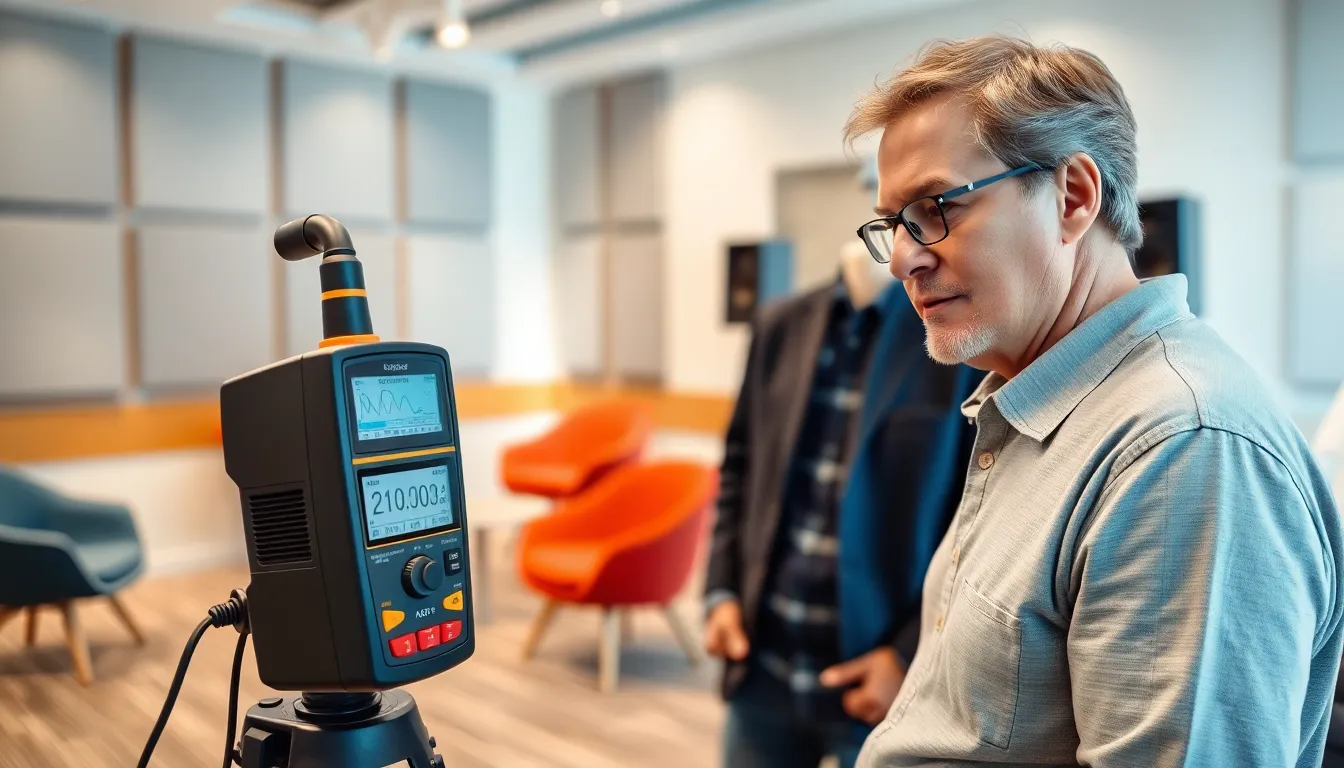Ever wondered why your living room sounds like a concert hall while your bedroom feels like a soundproof box? Measuring room acoustics isn’t just for sound engineers or musicians; it’s for anyone who wants to elevate their audio experience. Whether it’s for those epic movie nights or just jamming to your favorite playlist, understanding how sound behaves in a space can make all the difference.
Table of Contents
ToggleUnderstanding Room Acoustics
Room acoustics significantly impacts the quality of sound experiences. Understanding sound behavior in a space can enhance enjoyment for musical and cinematic activities.
The Importance of Acoustics in Interior Spaces
Acoustics play a vital role in how sound interacts within interior spaces. These interactions affect clarity and richness of sound. Quality acoustics enhance speech intelligibility in offices or classrooms, ensuring everyone hears clearly. In homes, better acoustics improve music enjoyment and movie experiences. Architects and designers must consider acoustics when designing spaces for optimal sound quality. Each space can either amplify or dampen sound, influencing the overall atmosphere.
Key Factors Affecting Room Acoustics
Several factors influence room acoustics, including size, shape, and materials. Room dimensions define sound wave behavior; larger spaces can create echoes, while smaller rooms might lead to unintended sound reflections. Hard surfaces like concrete and glass tend to reflect sound, causing clarity issues. In contrast, softer materials such as carpets and curtains absorb sound, reducing echoes. Equipment placement also matters; speakers and furniture arrangement impact how sound distributes. Understanding these elements aids in achieving the desired acoustic environment.
Methods for Measuring Room Acoustics

Measuring room acoustics involves various techniques that provide essential information about sound quality in different environments. Employing both objective and subjective methods can yield comprehensive insights.
Objective Measurement Techniques
Objective measurement techniques utilize tools and instruments for precise data collection. Sound level meters capture decibel levels in various locations within the space. Frequency analyzers assess sound frequency response, revealing how different tones behave in the room. Room impulse response measurements help evaluate sound reflections, providing a detailed view of how sound interacts with surfaces. By analyzing this data, individuals can identify acoustic issues like echoes or dead spots. Implementing these measurements leads to informed decisions on improving acoustics, thus enhancing overall sound quality.
Subjective Assessment Methods
Subjective assessment methods rely on human perception and experience for evaluating room acoustics. Listening tests allow individuals to assess clarity, warmth, and overall sound characteristics. Surveying preferences through questionnaires can highlight specific areas of concern, such as unwanted reverberation or lack of bass response. Small focus groups can provide feedback on audio quality in various scenarios, enriching the understanding of how sound influences listener enjoyment. Combining subjective assessments with objective measurements creates a comprehensive evaluation, addressing both technical and experiential aspects of room acoustics.
Tools and Equipment for Measurement
Various tools and equipment are essential for measuring room acoustics effectively. Selecting the right instruments can significantly influence the accuracy of sound assessments.
Professional Acoustic Analyzers
Professional acoustic analyzers provide comprehensive measurements of sound levels, frequency response, and reverberation time. Equipped with advanced features, these devices can capture and analyze complex sound interactions within a room. Common models include calibrated microphones and portable analyzers, which enable precise evaluation of acoustic conditions. Users often rely on these analyzers to identify specific issues like echoes and dead spots. Data obtained from these tools leads to informed decisions about sound treatment and design modifications. Detailed analysis reports can guide sound engineers and architects in optimizing space functionality and enjoyment.
DIY Measurement Tools
DIY measurement tools can serve as cost-effective alternatives for those seeking to analyze room acoustics. Smartphone apps offer basic sound level metering, providing users with a simple way to assess sound levels. Additionally, home audio equipment, such as microphones and speakers, can be repurposed for measuring frequency response. Involvement in community acoustic workshops encourages hands-on learning and familiarization with measurement techniques. Users often combine their findings from DIY tools with professional advice for comprehensive assessments. This approach leads to valuable insights, making acoustic improvement accessible even to those without specialized training.
Analyzing Acoustic Measurements
Analyzing acoustic measurements reveals insights about sound behavior in different environments. It involves interpreting data to identify acoustic performance and make informed adjustments.
Interpretation of Acoustic Data
Interpreting acoustic data entails understanding the meaning of various metrics collected during measurements. Analysts evaluate frequency response to determine how different frequencies are represented in a space. Decibel levels provide information about sound intensity, while reverberation time indicates how quickly sound dissipates. Observing these elements helps identify issues like excessive echoes or sound dead zones. They assess how these factors contribute to overall audio quality and user experience, guiding necessary changes.
Common Acoustic Metrics and Their Significance
Common acoustic metrics include sound pressure level, frequency response, and reverberation time. Sound pressure level measures the loudness of sound, crucial for ensuring comfort in spaces. Frequency response charts illustrate how different frequencies behave, impacting clarity and richness of sound. Reverberation time refers to the duration sound persists in a space, affecting speech intelligibility and musical accuracy. Each metric provides valuable insights, allowing engineers and designers to refine acoustic environments. Understanding these metrics leads to improved audio experiences, satisfying users across various venues.
Applications of Measured Room Acoustics
Measuring room acoustics serves various applications that enhance audio experiences across multiple environments.
Enhancing Sound Quality in Different Environments
Improved sound quality benefits spaces like offices, theaters, and homes. Speech intelligibility increases in corporate settings, allowing for effective communication amidst ambient noise. In concert halls, well-measured acoustics contribute to richer musical experiences for audiences. Private listening rooms benefit from controlled sound reflections that optimize music enjoyment. Classrooms that adopt acoustic enhancements create more focused learning environments, reducing distractions. Consistently, all environments maximize their audio potential through proper acoustic management, leading to more engaging experiences.
Architectural and Design Considerations
Architects and designers often incorporate measured acoustics into their projects. Thoughtful space planning maximizes acoustical performance, influencing the overall atmosphere of a building. Sound-absorbing materials can be integrated into various surfaces, including ceilings, walls, and flooring, aiding in the reduction of echoes. Considerations like room shape, size, and intended use play essential roles in acoustic effectiveness. Spaces designed for community gatherings require different acoustic treatments than those for personal use. Ultimately, measurement data guides decisions that lead to visually appealing and acoustically effective designs, ensuring user satisfaction and comfort.
Measuring room acoustics is vital for anyone seeking to enhance their audio experiences. By understanding how sound behaves in different environments, individuals can make informed decisions that significantly improve sound quality. Whether through professional tools or DIY methods, the ability to assess and analyze acoustics empowers users to create spaces that are not only visually appealing but also acoustically effective.
Incorporating the right materials and thoughtful design can transform an ordinary room into a haven for music and conversation. Ultimately, prioritizing room acoustics leads to richer audio experiences that resonate across various settings, ensuring that sound quality meets the expectations of users everywhere.

